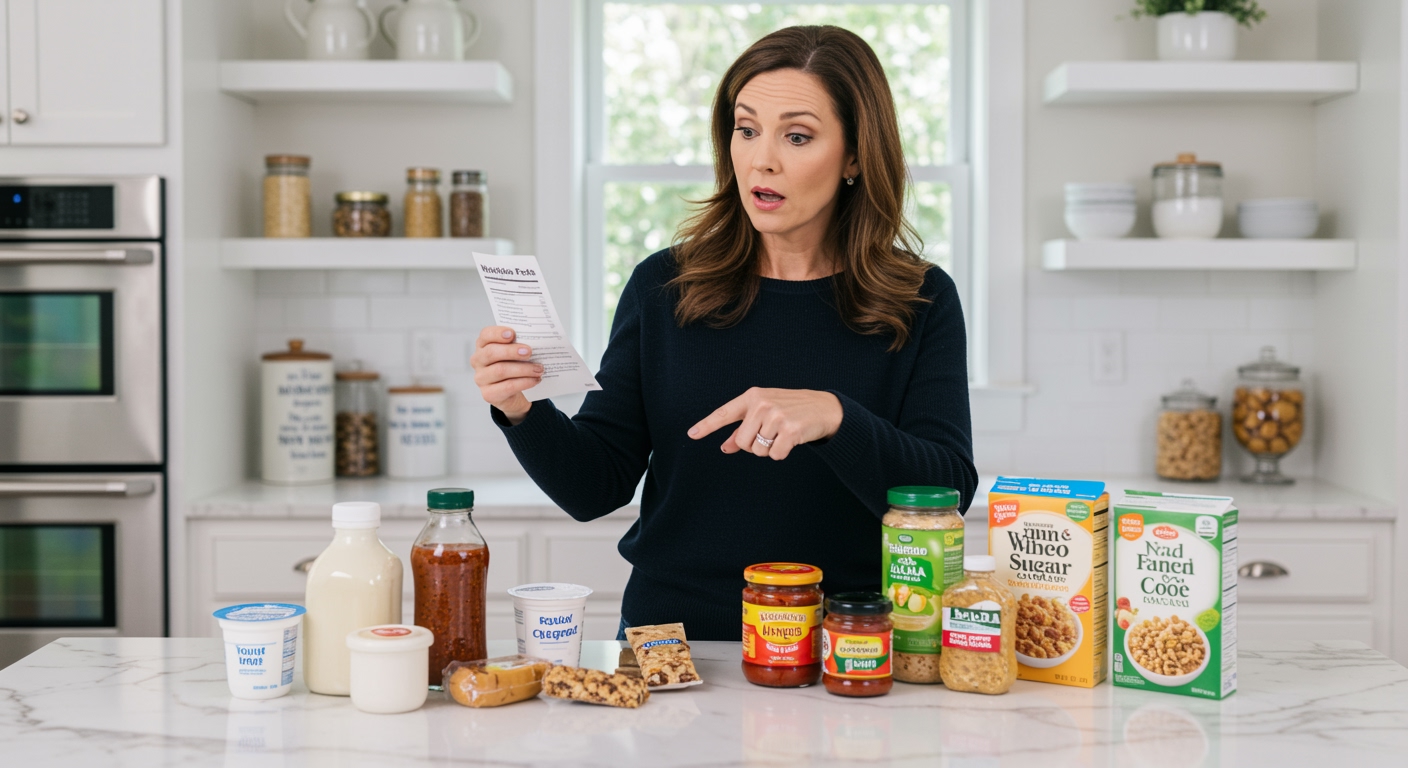✪ Key Takeaway: Most adults consume 75 grams of sugar daily through hidden sources, which is three times the recommended 25 grams per day.
Introduction
You carefully avoid desserts and never add sugar to your coffee, yet you still feel tired after meals and struggle with weight gain.
The problem lies in the hidden sugars that food companies cleverly disguise in everyday products you consider healthy.
Hi, I’m Abdur, your nutrition coach and today I’m going to reveal how processed foods are secretly sabotaging your health with sugar levels that would shock you.
Where Are These Hidden Sugars Actually Hiding?
Food manufacturers add sugar to products you would never suspect contain sweeteners.
A single serving of pasta sauce contains 6-12 grams of added sugar, which equals 3 teaspoons of pure sugar.
Your morning yogurt cup delivers 15-20 grams of sugar, often more than a chocolate chip cookie.
Salad dressings transform your healthy greens into sugar bombs with 2-4 grams per tablespoon.
Even whole grain bread contains 2-4 grams of sugar per slice, and most people eat two slices per sandwich.
Breakfast cereals marketed as healthy options pack 10-15 grams of sugar per serving, and that serving size is usually much smaller than what you actually pour into your bowl.
These hidden sources accumulate throughout your day without you realizing the massive sugar load hitting your bloodstream.
✪ Pro Tip: Read ingredient lists and look for sugar hiding under 60 different names including high fructose corn syrup, dextrose, and maltose.
Why Do Food Companies Add So Much Sugar?
Sugar acts as a powerful flavor enhancer that makes processed foods taste better and keeps you coming back for more.
Food scientists understand that sugar triggers dopamine release in your brain, creating a mild addiction cycle that increases sales.
Sugar also serves as a preservative that extends shelf life, allowing products to sit in warehouses and stores for months without spoiling.
Companies use sugar to mask the bitter or bland taste of artificial ingredients and chemical preservatives.
The bliss point is a food industry term describing the perfect combination of sugar, salt, and fat that makes foods irresistible.
Manufacturers spend millions of dollars researching this bliss point to ensure you crave their products over competitors.
This calculated approach to food engineering prioritizes profits over your health, leading to the current obesity and diabetes epidemic.
✪ Fact: The average American consumes 152 pounds of sugar per year, compared to just 4 pounds in 1700.
What Happens When You Consume This Much Sugar Daily?
Consuming 75 grams of sugar daily creates a constant blood sugar roller coaster that wreaks havoc on your metabolism.
Your pancreas works overtime producing insulin to manage these repeated sugar spikes, eventually leading to insulin resistance.
Excess sugar gets converted to visceral fat around your organs, particularly your liver, creating the dangerous belly fat that increases disease risk.
High sugar intake triggers chronic inflammation throughout your body, accelerating aging and increasing your risk of heart disease.
Your brain becomes dependent on these sugar hits for energy, causing afternoon crashes and constant cravings for more sweet foods.
The liver can only process about 25 grams of fructose per day, so consuming triple that amount forces your liver to convert excess sugar into fat.
This process leads to fatty liver disease, which affects 25% of adults and can progress to serious liver damage without symptoms.
✪ Note: Your taste buds adapt to high sugar levels within 2-3 weeks, making naturally sweet foods taste bland.
How Can You Identify And Avoid These Hidden Sugars?
The ingredient list tells the real story about sugar content, not the marketing claims on the front of packages.
Ingredients are listed by weight, so if sugar appears in the first five ingredients, that product contains significant amounts.
Look for multiple sugar sources throughout the ingredient list, as companies split sugar into different types to hide the total amount.
Choose products with less than 5 grams of sugar per serving, and always check the serving size against what you actually eat.
Focus on whole foods that do not require ingredient lists, such as fresh vegetables, fruits, lean proteins, and plain grains.
When buying packaged foods, select options where sugar appears after the seventh ingredient or not at all.
Prepare more meals at home using fresh ingredients to control exactly what goes into your food and avoid hidden sugars entirely.
✪ Pro Tip: Shop the perimeter of grocery stores where fresh, unprocessed foods are located to naturally avoid hidden sugars.
The Bottom Line
Your daily sugar intake is likely three times higher than recommended due to hidden sugars in processed foods that seem healthy.
The food industry profits from your confusion, but knowledge gives you the power to make choices that truly support your health.
I would love to hear about your experiences discovering hidden sugars in foods you thought were healthy, so please share your thoughts and questions in the comments below.
References
At NutritionCrown, we use quality and credible sources to ensure our content is accurate and trustworthy. Below are the sources referenced in creating this article:
- Johns Hopkins Medicine: Finding the Hidden Sugar in the Foods You Eat
- American Heart Association: How Much Sugar Is Too Much
- Harvard Health: Added Sugar: Where Is It Hiding
- CDC: Spotting Hidden Sugars in Everyday Foods

